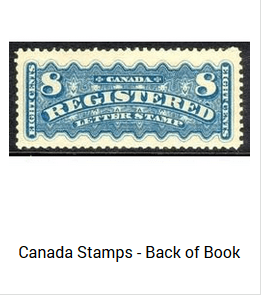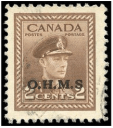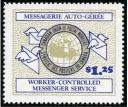 Many people new to stamp collecting might wonder what BOB stamps are. No, they have nothing to do with your Uncle Bob (sorry, bad joke)! The word BOB is simply an acronym for «Back Of Book». «Which book?» you may ask. The back of your stamp catalogue of course! This article will concentrate on the listings found at the back of your Unitrade Specialized Catalogue of Canadian Stamps. **see note
Many people new to stamp collecting might wonder what BOB stamps are. No, they have nothing to do with your Uncle Bob (sorry, bad joke)! The word BOB is simply an acronym for «Back Of Book». «Which book?» you may ask. The back of your stamp catalogue of course! This article will concentrate on the listings found at the back of your Unitrade Specialized Catalogue of Canadian Stamps. **see note
What Are BOB Stamps?
BOB stamps were special stamps issued for a specific purpose other than regular surface mail. These stamps are usually listed in your Unitrade catalogue with a specific letter preceding a number (for example: Canada postage due stamp #1 is listed as «J1»). What some people will sometimes call BOB stamps can include everything located at the back of the catalogue, but at Arpin Philately BOB stamps specifically refer to:
- Semi-Postal (B)
- Air Mail (C)
- Special Delivery (E)
- Registration (F)
- Postage Due (J)
- War Tax (MR)
- Official (O)
- Semi-Official (N)
- Stick ‘n Tic (ST)
Other special category stamps that can be found at the back of the Unitrade catalogue include Provinces, Revenue stamps and Wildlife Conservation stamps (otherwise known as «Duck Stamps»). These stamps fall under their own separate listing on our website and will each be discussed in a future article.
Definition of Canada Back Of Book Stamps

Semi-Postal Stamps
The first of these stamps was issued in Canada in 1974. Their purpose was to raise money for the 1976 Montreal Olympics. The surcharge printed on the stamp indicated how much of the cost of the stamp would be donated to a special cause. In recent years, Semi-Postal stamps have raised money and awareness for such causes as Literacy and Mental Health.

Air Mail Stamps
Air Mail stamps were issued in Canada from 1928-1946. Their purpose is evident-these stamps were used for mail sent by air as opposed to surface mail. Air mail is still more expensive than surface mail, which accounts for the higher cost of these stamps. Interesting fact: the first Air Mail stamp was used in the USA in 1859 when 123 letters were sent by balloon from Lafayette, Indiana to NYC. Unfortunately, the balloon only made it to Crawfordsville, Indiana due to poor weather conditions.

Special Delivery Stamps
Issued from 1898-1946, these stamps are used to pay for expediting the delivery of mail. Today, this service is called Xpresspost….and we all now how much it costs!!

Registration Stamps
Canada issued Registration stamps from 1875-1888. These stamps were used so that the postal service could keep track of a letter and make sure it got to its destination. The sender received a proof of deposit and a confirmation of delivery. We still have this service today when we pay extra for signature upon delivery.

Postage Due Stamps
These stamps were issued from 1906-1978. Basically, if the post office realized that the postage on the envelope was insufficient, they would stick one of these stamps on the letter indicating how much more postage was needed. It was the receiver who had to pay the difference if he/she wanted their letter (thanks a lot!). It was the obligation of the postman to collect the money owed. Nowadays, your letter would simply be sent back to you by the post office with the balance owing written on the envelope, which you would then have to add and resend your letter.

War Tax Stamps
These stamps were issued in 1915 and 1916, during the First World War. The cost of these stamps was a surcharge that the sender had to pay in addition to the cost of the regular stamp. Adding war tax stamps to an envelope was mandatory for all users of the postal service for those two years. The money raised went to support the war effort.

Official Stamps
Issued from 1923-1963, these stamps were used for mail sent from, or by, an authorized government agency. The first Official stamps had OHMS (On His Majesty’s Service) perforated onto the stamps. In 1949, stamps were overprinted OHMS. Then, in 1950, Official stamps were overprinted with the letter «G» (for government).

Semi-Official Stamps
These stamps were used to perform delivery services by individual companies, carriers and organizers. These various organisations were authorized by the government to deliver mail and even issue their own stamps bearing their company name and logo.

Stick ‘n Tic Stamps
Not stamps as such, but labels affixed to envelopes and used to speed up automatic sorting of the Christmas mail. They were tried out in Winnipeg first and then other cities adopted the labels also during the busy holiday season. The experiment only lasted from 1983-84.
Collecting BOB Stamps
There was a time when a lot of these stamps were not considered as serious items to collect. However, they now have their rightful place in philatelic history and in the minds and hearts of serious collectors. Many of these stamps are quite rare today and can fetch surprising amounts at auction.
** Note: not all stamp catalogues function the same way, but the Unitrade catalogue and the Scott USA catalogue list these special stamps at the back of their catalogues.
Interesting. What about “Law Stamps” and “Weights and Measures Stamps”?
We have these listed in the « Revenue » category: https://www.arpinphilately.com/cat/canada-revenue-stamps
Hi lisa. I found your article on ‘fancy cancels’ so interesting. I am in Australia so I will now look out for these cancels as I collect all countries. Many thanks. Norma
Good luck!